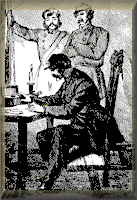USGenWeb Free Census Project Help, What is involved in being a second transcriber?
Every transcription must have a second transcriber. Censuses are a GREAT genealogical resource, but... they also leave much to individual interpretation. Poor penmanship, individual style... are all contributors!! One could lose their "senses"! The possibility of misinterpretation is diminished with second transcribers!
Taking the original transcription and checking it entry by entry against the microfilm for accuracy, noting corrections, comments about questionable items, etc. and then discussing with the original transcriber and agreeing on what is the correct entry to be submitted as the final transcription. If an agreement can't be reached, the second transcriber notes what they see in the Remarks Columns with the preface, "Proofreader see xx as xxxxx." Remember, these transcriptions are to be exactly as they appear on the original, errors and all!
Finding a 1st transcription that has already been completed or in progress that you would be willing to complete by doing a 2nd transcription. You do this by going to the state/year pages from http://www.usgwcensus.org/states.htm and looking for the completed 1st transcriptions.
What will you need to perform a second transcription?
1. You will receive a database (.dbf or .xls or .wks or ect.) file or a text file
from either the transcriber or your state census coordinator.
2. You import this database into the same transcription program used by the
transcriber, and print out a paper report.
3. Now you take this report to the place where the microfilm you are using is
located and compare the two.
4. Note every difference or discrepancy, no matter how small or how numerous,
and contact the transcriber.
5. The transcriber and proofreader then compare the two versions and settle on an
agreed solution to all discrepancies, thus determining the final version to be used.
6. In order to proofread these records, you must have access to the microfilm and
a microfilm reader, usually at a private or public library. There is nearly always
one within convenient distance of you. (NOTE: A CD image of the actual microfilm
will work as well but usually the actual microfilm is a better source.)
Other Information About Second Transcriptions
In some cases, the original enumeration schedules may be proofread in other ways, such as from photocopies or CD-ROM computer images taken from the microfilm, but in all cases it must be remembered that microfilm provides the highest quality source. Proofreading can never be done from previously published transcriptions (transcriptions done outside this project, often incomplete or poorly done). The Census Project requires that at least one of either the transcribing or the proofreading be done from the microfilm, and strongly recommends that ALL proofreading be done in this manner.
When we say proofreading, we mean much more than a casual check for typographical errors. In our system, proofreading is essentially a second independently performed transcription. Every single entry on every single line is to be checked against the microfilm original. Every discrepancy must be noted, whether data entry error, omission or addition, or simply a different interpretation of spelling used in hard to read handwriting. Our transcriptions are to include every single thing found in the original record, "right" or "wrong," and are to include nothing that is not found there (see exceptions to this rule regarding surnames, family and dwelling numbers, and usage of ditto on the Census Help Pages).
So far, so good. But..... How long is this all going to take? Good question. The time to do this will vary with each transcription. The size of the enumerated population, the legibility of the enumerator's handwriting, and the number of discrepancies found will all be factors. In any case, proofreading takes less time and is easier than creating the initial transcription, but equally important in producing the most accurate and faithful reproduction of the original record that is possible.
Sign Up To Be A Second Transcriber at http://www.usgwcensus.org/proof/sign/.
What to expect after the sign up has been submitted.
1. You will receive a welcome letter.
2. You will need to submit to us some information.
3. Once this information is submitted you will receive an assignment confirmation,
be added to the Census Transcriber
Mailing List (USGWARCH-CEN-L) and further information.
Sign Up To Be A Second Transcriber
If you are a transcriber looking for someone to proofread your transcription, please contact your state census coordinator or me at cp@maggie-sz.org.
If you can't find a proofreader do submit your transcription so it can be shared online until one if found.


